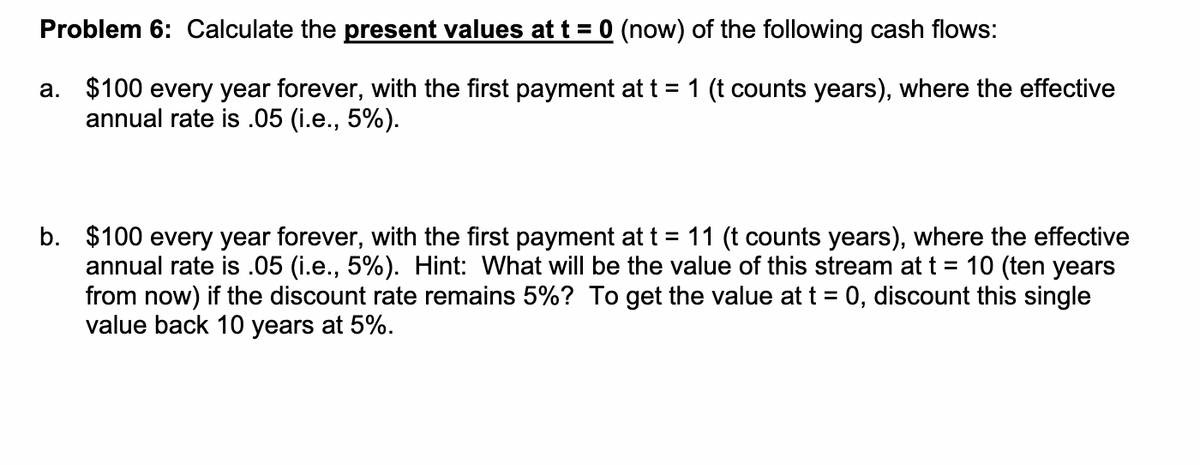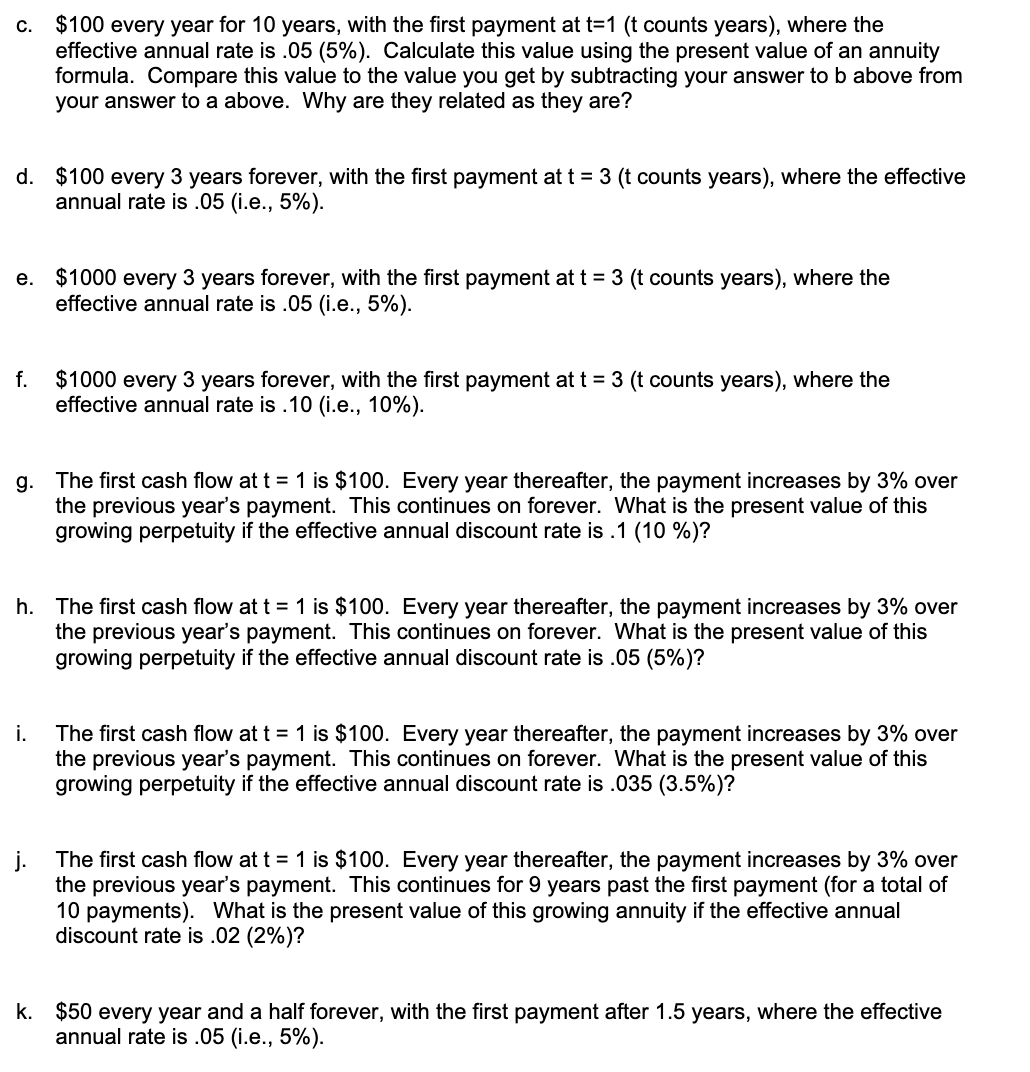The first cash flow at t = 1 is $100. Every year thereafter, the payment increases by 3% over g. the previous year's payment. This continues on forever. What is the present value of this growing perpetuity if the effective annual discount rate is .1 (10 %)? h. The first cash flow at t = 1 is $100. Every year thereafter, the payment increases by 3% over the previous year's payment. This continues on forever. What is the present value of this growing perpetuity if the effective annual discount rate is .05 (5%)? i. The first cash flow at t = 1 is $100. Every year thereafter, the payment increases by 3% over the previous year's payment. This continues on forever. What is the present value of this growing perpetuity if the effective annual discount rate is .035 (3.5%)?
The first cash flow at t = 1 is $100. Every year thereafter, the payment increases by 3% over g. the previous year's payment. This continues on forever. What is the present value of this growing perpetuity if the effective annual discount rate is .1 (10 %)? h. The first cash flow at t = 1 is $100. Every year thereafter, the payment increases by 3% over the previous year's payment. This continues on forever. What is the present value of this growing perpetuity if the effective annual discount rate is .05 (5%)? i. The first cash flow at t = 1 is $100. Every year thereafter, the payment increases by 3% over the previous year's payment. This continues on forever. What is the present value of this growing perpetuity if the effective annual discount rate is .035 (3.5%)?
Cornerstones of Financial Accounting
4th Edition
ISBN:9781337690881
Author:Jay Rich, Jeff Jones
Publisher:Jay Rich, Jeff Jones
ChapterA3: Time Value Of Money
Section: Chapter Questions
Problem 17E
Related questions
Question
need parts g, h, i, j, and k

Transcribed Image Text:Problem 6: Calculate the present values at t = 0 (now) of the following cash flows:
a. $100 every year forever, with the first payment at t = 1 (t counts years), where the effective
annual rate is .05 (i.e., 5%).
b. $100 every year forever, with the first payment at t = 11 (t counts years), where the effective
annual rate is .05 (i.e., 5%). Hint: What will be the value of this stream at t = 10 (ten years
from now) if the discount rate remains 5%? To get the value at t = 0, discount this single
value back 10 years at 5%.

Transcribed Image Text:c. $100 every year for 10 years, with the first payment at t=1 (t counts years), where the
effective annual rate is .05 (5%). Calculate this value using the present value of an annuity
formula. Compare this value to the value you get by subtracting your answer to b above from
your answer to a above. Why are they related as they are?
d. $100 every 3 years forever, with the first payment at t = 3 (t counts years), where the effective
annual rate is .05 (i.e., 5%).
e. $1000 every 3 years forever, with the first payment at t = 3 (t counts years), where the
effective annual rate is .05 (i.e., 5%).
$1000 every 3 years forever, with the first payment at t = 3 (t counts years), where the
effective annual rate is .10 (i.e., 10%).
f.
g. The first cash flow at t = 1 is $100. Every year thereafter, the payment increases by 3% over
the previous year's payment. This continues on forever. What is the present value of this
growing perpetuity if the effective annual discount rate is .1 (10 %)?
h. The first cash flow at t = 1 is $100. Every year thereafter, the payment increases by 3% over
the previous year's payment. This continues on forever. What is the present value of this
growing perpetuity if the effective annual discount rate is .05 (5%)?
i.
The first cash flow at t = 1 is $100. Every year thereafter, the payment increases by 3% over
the previous year's payment. This continues on forever. What is the present value of this
growing perpetuity if the effective annual discount rate is .035 (3.5%)?
The first cash flow at t = 1 is $100. Every year thereafter, the payment increases by 3% over
the previous year's payment. This continues for 9 years past the first payment (for a total of
10 payments). What is the present value of this growing annuity if the effective annual
discount rate is .02 (2%)?
k. $50 every year and a half forever, with the first payment after 1.5 years, where the effective
annual rate is .05 (i.e., 5%).
Expert Solution
This question has been solved!
Explore an expertly crafted, step-by-step solution for a thorough understanding of key concepts.
This is a popular solution!
Trending now
This is a popular solution!
Step by step
Solved in 2 steps

Knowledge Booster
Learn more about
Need a deep-dive on the concept behind this application? Look no further. Learn more about this topic, finance and related others by exploring similar questions and additional content below.Recommended textbooks for you

Cornerstones of Financial Accounting
Accounting
ISBN:
9781337690881
Author:
Jay Rich, Jeff Jones
Publisher:
Cengage Learning


EBK CONTEMPORARY FINANCIAL MANAGEMENT
Finance
ISBN:
9781337514835
Author:
MOYER
Publisher:
CENGAGE LEARNING - CONSIGNMENT

Cornerstones of Financial Accounting
Accounting
ISBN:
9781337690881
Author:
Jay Rich, Jeff Jones
Publisher:
Cengage Learning


EBK CONTEMPORARY FINANCIAL MANAGEMENT
Finance
ISBN:
9781337514835
Author:
MOYER
Publisher:
CENGAGE LEARNING - CONSIGNMENT

Principles of Accounting Volume 2
Accounting
ISBN:
9781947172609
Author:
OpenStax
Publisher:
OpenStax College

